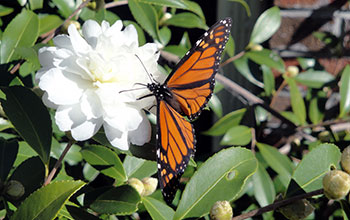Multimedia Gallery
A monarch butterfly feeds on camellia flowers
A monarch butterfly feeds on camellia flowers.
More about this image
New discoveries about how butterflies feed could help engineers develop tiny probes that siphon liquid out of single cells for a wide range of medical tests and treatments.
The research, which is funded by the National Science Foundation (NSF), is bringing together Clemson University materials scientists and biologists, who have been focusing on the butterfly proboscis, the mouthpart that many insects use for feeding.
Materials scientists, led by Konstantin Kornev, a materials physics professor at Clemson, are working to develop what they call "fiber-based fluidic devices" and include probes. Kornev says they could eventually allow doctors to remove a single defective gene out of a cell and replace it with a good one.
Kornev chose butterflies as his test subject due to their ability to draw various types of liquids -- both thick like nectar and honey and thin like water. The probe would be able to draw fluid out of a single cell -- which is 10 times smaller than the diameter of a human hair--and be able to differentiate between different types of fluids. The technology would have applications in medical devices, nano-bioreactors that make complex materials and flying "micro-air vehicles" the size of an insect.
The study is also furthering knowledge for Clemson biologists. While scientists know butterflies use the proboscis to suck up fluid (similar to how humans use a drinking straw), the biologists learned from the study that the butterfly proboscis also acts as a sponge. As butterflies move their proboscis around it helps sponge up the liquid and also facilitates delivery of the liquid so that it can be sucked up.
For the next phase of this research the researchers will seek to understand how the proboscis forms, and will work to develop a way to keep the probe from getting covered with organic material when it's inserted into the body.
[Note: This material is based on work supported by NSF grants IOS 1354956, EFRI 0937985 and PHY 1305338.]
To learn more about this research, see the NSF News From the Field story Butterflies could hold key to probes that repair genes. (Date image taken: 2012-2014; date originally posted to NSF Multimedia Gallery: Sept. 30, 2015) [Image 3 of 3 related images. Back to Image 1.]
Credit: Konstantin Kornev, Clemson University
See other images like this on your iPhone or iPad download NSF Science Zone on the Apple App Store.
Images and other media in the National Science Foundation Multimedia Gallery are available for use in print and electronic material by NSF employees, members of the media, university staff, teachers and the general public. All media in the gallery are intended for personal, educational and nonprofit/non-commercial use only.
Images credited to the National Science Foundation, a federal agency, are in the public domain. The images were created by employees of the United States Government as part of their official duties or prepared by contractors as "works for hire" for NSF. You may freely use NSF-credited images and, at your discretion, credit NSF with a "Courtesy: National Science Foundation" notation.
Additional information about general usage can be found in Conditions.
Also Available:
Download the high-resolution JPG version of the image. (5.4 MB)
Use your mouse to right-click (Mac users may need to Ctrl-click) the link above and choose the option that will save the file or target to your computer.

